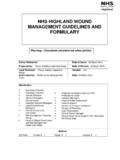Transcription of Identification of Biomarkers by Proteomics for Prenatal ...
1 Tohoku J. Exp. Med., 2016, 238, 123-129 Prenatal screening for neural Tube Defect 123. Identification of Biomarkers by Proteomics for Prenatal screening for neural Tube Defects Guosong Shen,1 Pingya He,1 Ying Du1 and Su Zhang1. 1. Prenatal Diagnostic Center, Huzhou Maternal & Child Care Hospital, Huzhou, Zhejiang, China neural tube defect (NTD) is a serious congenital defect, but current methods for identifying NTD are limited. We used proteomic analysis of maternal serum to identify NTD-specific proteins whose levels differed between women with NTD fetuses (n = 50) and those with healthy fetuses (n = 40). Three NTD-specific protein peaks (8, , 15, , and 3, m/z) were identified using MALDI-TOF-mass spectrophotemetry, and were included in a diagnostic model developed using Biomarker Patterns software. The model used cut-offs for the relative intensity of the three peaks to indicate if a case had or did not have NTD.
2 The model identified 48 of the 50 NTD cases and 36 of the 40 control cases correctly, resulting in the sensitivity of (48/50) and the specificity of (36/40). The diagnostic model was also tested on 105 clinical cases at high risk for NTD, as determined by having high alpha-fetoprotein levels, resulting in the sensitivity of 100% (101/101) and the specificity of (3/4). Using the International Protein Index database, we identified proteins with a molecular mass of 8, Da as ADP-ribosylation factor 1 and a protein similar to cold agglutinin FS-1 antibody light-chain. The 15, peak corresponded to vitamin K3 protein, and the identity of the 3, protein was unclear. Thus, this study developed a diagnostic model consisting of the three peaks which may be indicators of NTD. This new assay may be at least as accurate for diagnosing NTD compared with the commonly used clinical test that assesses alpha- fetoprotein levels.
3 Keywords: congenital disorder; MALDI-TOF mass spectrometry; neural tube defect; Prenatal diagnosis; Prenatal screening Tohoku J. Exp. Med., 2016 February, 238 (2), 123-129. 2016 Tohoku University Medical Press tion of the fetus, maternal obesity, and the technical skill of Introduction the person(s) performing the ultrasound (Chan et al. 1995). neural tube defects (NTDs) are complex congenital Elevated levels of alpha-fetoprotein (AFP) in the amniotic malformations of the central nervous system occurring sec- fluid and maternal serum are also used during the second ondarily to lack of closure of the neural tube. The world- trimester to screen for NTDs in fetuses; however, the speci- wide incidence ranges from to per 1,000 births ficity and sensitivity of AFP is limited (Chen 2008; Salih et (Salih et al. 2014). In China, the prevalence of NTDs is al.)
4 2014). about 6 per 1000 births which is considerably higher than In this study, proteomic analysis of maternal serum that in the United States (about 5 in 10,000 births) and in was conducted to identify NTD-specific protein peaks as Western Australia (about 15 per 10,000 births) (Moore et al. Biomarkers for NTD. The aim was to develop a non-inva- 1997; Boulet et al. 2008; Bower et al. 2009). Folate supple- sive and safe method with high specificity for Prenatal mentation both before and during the initial weeks of preg- detection of NTDs. We used nano-magnetic beads and nancy reduces the risk of NTDs, with a protective rate of MALDI-TOF-MS for this study to identify proteins that about 50-80% (MRC Vitamin Study Research Group 1991; have different expression patterns in NTD compared with Czeizel et al. 2004; Chen 2008). non-NTD fetal samples.
5 This technology has high sensitiv- About 95% of NTDs occur spontaneously in women ity and specificity and has been widely used for screening without family history of the disease, indicating the impor- and Identification of Biomarkers for various diseases and tance of Prenatal screening to detect NTDs (Chen 2008). tumor including breast cancer, colorectal cancer, and oral Ultrasound is used to detect NTDs (Lepage et al. 2012); cancer with (Mengel-Jorgensen et al. 2004; Villanueva et however, the accuracy of detecting NTDs by ultrasounds is al. 2004, 2007; Cheng et al. 2005; Lopez et al. 2005; de affected by a number of factors including prevalence, posi- Noo et al. 2006; Hortin 2006). Received August 27, 2015; revised and accepted December 24, 2015. Published online Janaury 23, 2016; doi: Correspondence: Su Zhang, Prenatal Diagnostic Center, Huzhou Maternal & Child Care Hospital, Huzhou, Zhejiang Province 313000, China.
6 E-mail: 123. 124 G. Shen et al. spot on the chip was scanned 90 times. Ciphergen ProteinChip Materials and Methods software was used to collect data. Data process modeling included This prospective, controlled study enrolled patients from standardization of parameters for proteome maps. The serum m/z Huzhou Maternity & Child Hospital, Zhejiang Province, China peak of 6, was used for calibration, followed by baseline between 2012 and 2013. The study was performed according to the reduction in order to minimize errors caused by factors such as chip Declaration of Helsinki. The protocol was approved by the institu- differences and fluctuations of the instrument. Biomarker Wizard tional review board of the Huzhou Maternal & Child Care Hospital software was used to calculate the P values of the differences of the and all subjects gave their written informed consent.
7 Proteins with the same m/z between fetal NTD group and the control group. Study subjects The protein peaks with a signal-to-noise ratio greater than 5 and Eligible subjects were women in their second trimester of preg- an occurrence rate higher than 90% was selected as valid protein nancy and whose fetus was diagnosed with NTD in accordance with peaks. Furthermore, to ensure small protein peaks were not missed, the standards of the Chinese Ministry of Health ( , by ultrasound all peaks with the signal-to-noise ratio of > 2 and molecular quality and pathology). Also included were healthy pregnant women (con- deviation < were also marked as valid protein peaks. After trols) and women at high risk for NTD fetuses for blinded validation further optimization of the parameters (including the Gini, Testing, of the Biomarkers . The high risk women were identified through Advance and Costs, etc.)
8 , the diagnostic model was determined. The analysis of AFP levels. A multiple of the median (MoM) was diagnostic model was used for blinded analysis in the NTD high-risk calculated by measuring AFP in maternal serum and comparing this pregnant women, and the sensitivity and the specificity of the results value to the median AFP value in an unaffected population. High-risk were analyzed by blinded analysis. subjects were defined as having AFP levels MoMs at 15 and 21 NTD-high risk women were identified by evaluating serum weeks of pregnancy (Wald and Cuckle 1987). levels of AFP, the level of which was determined by time-resolved fluoroimmunoassay employing europium-labeled antigen as a tracer. Biomarker analysis Multicalc software (Perkin Elmer Wallac, Tirku, Finland) calculated Serum preparation: Peripheral blood samples were collected the risk of NTD by inclusion of the factors of maternal age, and placed at 4 C immediately following collection, and subsequently gestational age and weight.
9 AFP levels MoMs indicated high centrifuged at 4 C at 4,000 r/min for 5 min to collect serum, followed risk. by additional centrifugation at 14,000 r/min for 5 min at 4 C to remove cell debris. Serum aliquots were stored at 80 C and each Diagnosis of NTD. sample was used only once. NTD was diagnosed using ultrasound (Toshiba Nemio with a NTD-related protein Identification : Proteins were isolated using probe frequency of MHz). The presence of anencephaly, weak cation exchange type nano-magnetic beads (Saierdi Biotech spina bifida aperta was evaluated. In addition, autopsy of NTD. Co., Ltd., Beijing, China). Serum samples were thawed on ice prior fetuses was used to evaluate the presence of NTD. to use. Samples (10 L) were added to 20 L of 9 mol/L buffer (9. mol/L Urea, 2% CHAPS, 50 mmol/Tris-HCl, 1% DTT, pH ) Statistical analyses (Sigma Aldrich, St.)
10 Louis, MO, USA) and incubated at room temper- P values of the proteins with the same m/z but with different ature for 10 min before being mixed with 360 L of weak cation expression levels between the NTD fetal group and control group exchange binding buffer. were calculated according to the principles of analysis of variance Weak cation exchange magnetic beads were washed twice and (ANOVA). Biomarker Patterns Software (Ciphergen Biosystems, equilibrated with binding buffer. A diluted serum sample of 100 L Fremont, CA, USA) was used for linear analysis of the differences was added and incubated at room temperature for 15 min after mix- between the differential protein peaks with the same m/z in NTD fetal ing. The magnetic processor was used to remove unbound sample group and control group. Mann-Whitney U test was used to compare and the weak cation exchange beads were then washed two times the protein peaks between the NTD fetal group and control group.





